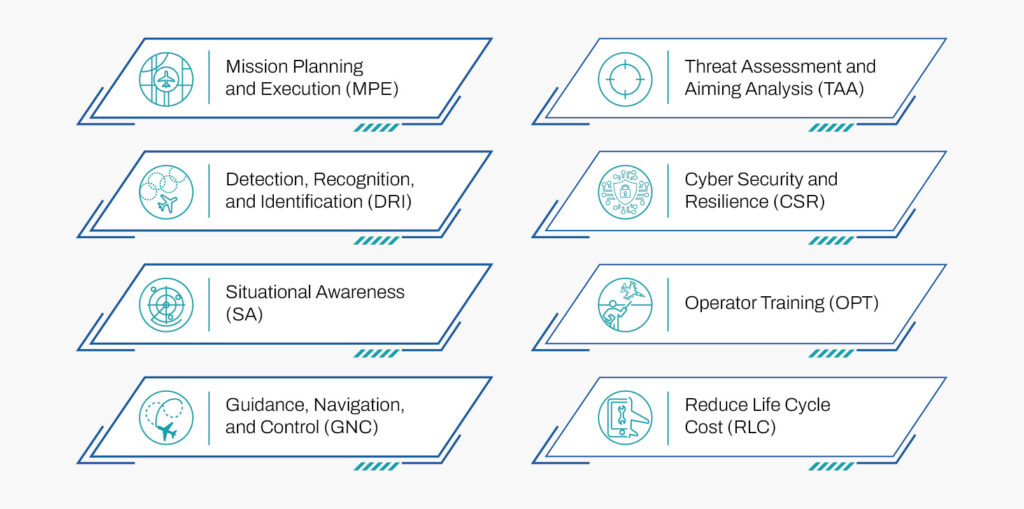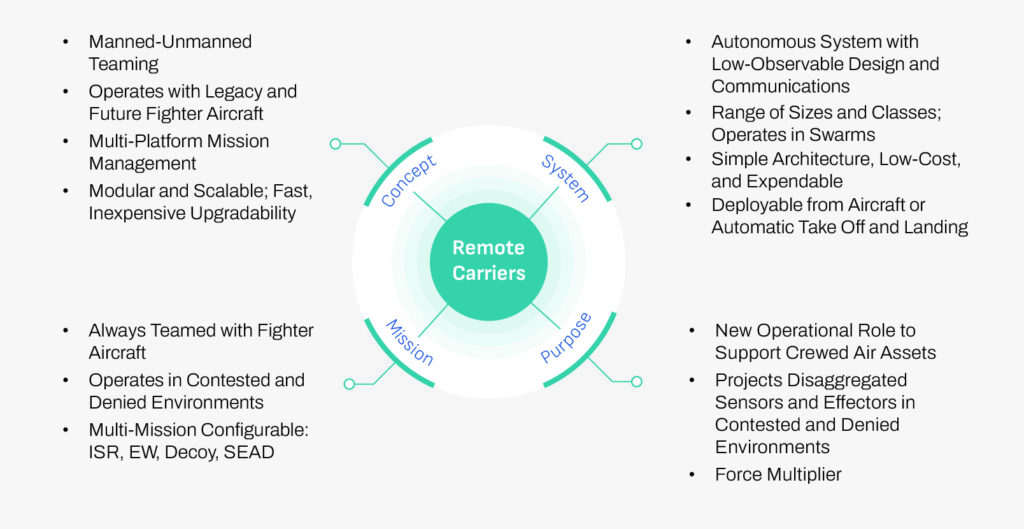Introduction
This century, according to Peter Singer, is witness “to the start of the greatest revolution that warfare has seen since the introduction of the atomic bomb,” and he follows up by arguing that “humankind is starting to lose its 5,000-year monopoly [on] fighting war” (Singer, 2009). This paper seeks to provide an endorsement, update, and, indeed, an extension of this powerful rhetoric by evaluating what might be termed a Military-AI-Industrial Revolution. As the term suggests, it represents transformative change through the impact of artificial intelligence (AI) on air power and its associated defense industrial base. All radical technology developments involving product change necessarily induce accommodating structural changes at the industrial level, and this revolution is no different. Waves of AI-enhanced innovation are sweeping away long-standing military and industrial capabilities, conventions, and structures. AI represents a step-change in military technology systems, and this paper focuses on five use applications of AI in next-generation air power delivery, namely, fully autonomous systems, virtual ‘avatar’ co-pilots, loyal wingmen, swarms (and swarms of swarms), and autonomous decoys.
Waves of AI-enhanced innovation are sweeping away long-standing military and industrial capabilities, conventions, and structures.
– Robert Murray
RMA and 4IR
The contemporary military environment is based on revolutionary change, transformative innovation, disruptive technologies, and, increasingly, AI-intensive force multipliers. The military has long been associated with technical revolutions, but today the process is more pervasive as it drives dramatic changes in doctrine, operational constructs, and command and control (C2). The Revolution in Military Affairs (RMA) is a characterization of fundamental change in an array of military domains, not just weapons systems but also related systems, such as those providing various support functions, such as logistics, acquisition, and R&D (Matthews, 2001).
There used to be an academic debate about whether military-related technical change is revolutionary, reflecting profound discontinuous technological changes, such as the arrival of iron-clad dreadnought power-driven warships, or evolutionary, via continuous incremental innovation. Over a relatively short time span, it is possible to discern ‘continuous’ incremental innovation within a revolutionary technological context. The evidence for this convergence has been evident since the Gulf War, where the dynamic has been one of the continuous waves of disruptive technological change, from stand-off guided munitions to space-based effects, stealth platforms, network-centric warfare, and recently, AI-enhanced robotics, machine learning, and other emerging technologies associated with the fourth industrial revolution (4IR).
The fourth industrial revolution (the first being steam mechanization; the second electricity and mass production; and the third being IT and electronics) is defined by dual-use technology carrying the potential for technological breakthroughs in the civil domain spinning off into the military domain and vice versa. Over time, air power has become increasingly sophisticated and R&D intensive. The resulting acceleration in innovation has transmogrified the underlying defense industrial base, initiating a shift from the traditional model of ‘primes’ acting as systems integrators that divvy work to hundreds of highly specialized, efficient, and innovative subcontractors across a spectrum of diverse industrial sectors. These suppliers comprise critical supply chains, which, through clustered proximity, engage in technical problem-solving with their prime customers to forge new and innovative solutions to technical challenges.
These ‘value’ chains were populated by specialized firms for generations, supplying essential services such as machine tools, telecommunications, specialty metals, castings, and wire harnesses. More recently, however, the skills inherent in value chains have evolved to focus on next-generation technologies and miniaturization; the latter due to the premium placed on space and weight in modern platforms. Taken together, the present ‘disruptive’ 4IR will drive a technological reset of both complex military systems and their underlying production processes.
Stand-out disruptive technologies include hypersonics, autonomous platforms, big data, quantum computing, and AI, with the latter arguably the biggest game-changer. For the first time, AI-assisted systems are emerging that can analyze the strategic environment, make decisions, and exhibit behavior requiring cognition; they operate in a virtual world represented by digital assistants and image analysis software that can be embedded into hardware in the real world, in robotics, drones, and similar systems (Okyay, 2023). This a world increasingly inhabited by robotics operating on a ‘sense-think-act’ basis, which reflects the ability to monitor the environment (sense), exploit AI to make decisions on how to respond (think) and activate effectors in response to these decisions (act) (Singer, 2009).
AI is central to this process, but caution needs to be exercised on how AI is defined. For instance, an unmanned aerial vehicle (UAV) controlled by a manned ground station is unmanned but not autonomous and, therefore, not an AI system (Naik, Fin Express 2023). By contrast, the Pentagon defines a fully autonomous system incorporating ‘general’ AI as a system able to independently compose and select, among different courses of action, to accomplish goals based on its knowledge and understanding of the world itself and the situation (Macintyre, 2018).
As yet, no fully autonomous system has been developed, but some 400 partially independent weapons and robotic systems are under development in twelve countries, including Israel; home of ‘Harpy,’ a ‘kamikaze’ drone whose purpose is to seek out and destroy radar systems on its own, without human permission, loitering in the sky until a target appears (Macintyre, 2018). AI-enhanced systems such as this will inevitably emerge and have a broader, more pervasive impact through fundamental changes in battlefield relationships, force structures, and the very character of war, creating a war-winning advantage in future conflicts (Wirtz, 2023).
Because disruptive innovations such as AI induce powerful advantages, strategic competition inevitably emerges driven by the imperative of breaching the status quo in the relative military balance of power. It has been estimated that investment by the United States and China into AI-enabled systems amounted to over US$3 billion in 2020, a figure likely to be an underestimate as additional funding would have been captured in R&D (Harper, National Defense, 2022; Harper, 2023; Albon and Demarest, 2023). Increasingly, militaries across the world are intensifying efforts to develop AI-enhanced technologies and establishing new structures and organizations to accelerate the development of these capabilities.

AI-Assisted Air Power
There is growing concern about the ethical dimensions of the AI revolution, particularly the potential removal of humans from decision-making in the military operational environment. Galliot and Schultz (2020), for example, argue trenchantly that allowing:
Life or death decisions to be made by machines crosses a fundamental moral line. Autonomous robots would lack human judgment and the ability to understand context. These qualities are necessary to make complex ethical choices on a dynamic battlefield, to distinguish adequately between soldiers and civilians, and to evaluate the proportionality of an attack. As a result, fully autonomous weapons would not meet the requirements of the laws of war. Replacing human troops with machines could make the decision to go to war easier, shifting the burden of armed conflict further onto civilians. The use of fully autonomous weapons would create an accountability gap as there is no clarity on who would be legally responsible for a robot’s actions: the commander, programmer, manufacturer, or robot itself. Without accountability, these parties would have less incentive to ensure robots did not endanger civilians, and victims would be left unsatisfied that someone was punished for the harm they experienced.
Notwithstanding these ethical dilemmas, AI’s footprint in air power is persuasive. Five uses for AI in air combat have emerged, all with the potential to dramatically alter the nature of warfare itself in the coming years. The first has regard to autonomous platforms, with the US forging ahead in this field, as evidenced by DARPA (2023) and its remarkable Air Combat Evolution (ACE) program. In less than three years, AI algorithms have enabled the transition from simulated F-16 aerial dogfights on computer screens to control an actual dogfight in flight.
Through close multi-partner collaboration between DARPA, the US Air Force Pilot Test School, the Air Force Research Laboratory, and AI-development contractors, ACE has achieved several objectives: firstly, it demonstrated that AI agents could control a full-scale fighter in flight; secondly, the program was designed to leapfrog over subscale phases and proceed directly to prototype implementation, saving at least a year in development, and; thirdly, ACE facilitated associated research into the ‘trust’ pilots exhibit in the AI agent during ‘within-visual-range air combat (dogfights), while the human pilot focuses on larger battle management tasks. The potential for an autonomous AI fighter aircraft appears immense, and this was demonstrated early in the ACE program when AI ‘agents’ flying simulated F-16s in a virtual dogfight competition defeated an experienced F-16 fighter pilot flying in a simulator.
A second significant AI-led development for air power relates to experimentation on the Eurofighter Typhoon’s successor, the sixth-generation Tempest aircraft. Tempest is a UK-led international collaborative Future Combat Aircraft System (FCAS), featuring Italy and Japan as full partners and Sweden on the margins (Martin, 2023). Tempest is well into its conceptualization stage and is planned to have both manned and unmanned versions, with the former anticipated to have an innovative virtual avatar (AI agent) as a co-pilot. The aircraft’s sensors controlling the avatar and other onboard systems are estimated to possess the capacity equivalent to the “internet traffic of a large city, such as Edinburgh, every second (Leonardo corporate website, 2020); and be able to process more than 10,000 times the military theatre data compared to its predecessor Typhoon aircraft (Fisher, 2020).
As with the F-16 AI agent, an essential role of the avatar is to determine when the human pilot becomes overloaded and then take over operational responsibility for a range of duties to allow the pilot to concentrate on ‘core’ combat tasks (Ford, 2020). The avatar also offers increased cost-effectiveness due to reductions in the aircraft’s weight, as well as operational flexibility through programming that allows response to multiple scenarios, including electronic jamming, weapons control, and, in the event of pilot loss, even control and landing of the aircraft (Makichuk, 2020).
The Tempest program also highlights a third AI-driven innovation, that of ‘loyal wingmen.’ These force multipliers are defined as low-cost UAVs deployed alongside a manned aircraft to either act as a complementary asset or as a decoy to protect the crewed system from adversarial air defenses (Stevenson, 2019). The Tempest is just one of several programs developing loyal wingmen, including others in France, the UK, and the US. For instance, Boeing’s Airborne Teaming System is an AI-assisted semi-autonomous, potentially stealthy loyal wingman called the MQ-28A Ghost Bat (Dangwal, 2022). The Ghost Bat can move towards an enemy alongside crewed aircraft, such as the F-35, performing missions independently and possessing a remarkable 3,700 km flight range (Perrett, 2021).

According to a Mitchell Aerospace Institute Report (2020), the adoption of loyal wingmen offers operational flexibility through AI-enabled autonomy and low-cost, attritable/reusable aircraft that would increase combat capacity, lethality, and survivability in contested environments. It is in addition to extending the effective sensor range and kill radius of F-22s, F-35As, and Next-Generation Air Dominance assets. Nevertheless, there are technical obstacles to overcome: firstly, interoperability is essential (Hadley, 2022); secondly, it remains unclear whether fighter pilots in action would have the time to manage semi-autonomous helpers; and thirdly, loyal wingmen would unlikely be able to accelerate away from a threat with anything like the speed of fighters, though their vulnerability may partly be compensated by stealth, and to some extent, they are also expendable assets (Perrett, 2021).
The advantages of this form of human-machine teaming appeal to militaries, as evidenced by the quickly maturing work by China on related drone ‘swarming’ technologies (Nurkin, 2020). Drone swarms represent the fourth of this paper’s AI-based aerospace systems, defined as a large number of animate or inanimate things massed together and usually in motion, which provide a method of combining situational awareness, elusiveness, mass, speed, mobility, and surprise (Sanders, 2017). Military operations using multiple UAVs have thus far limited the number of craft involved to single or double digits. Still, DARPA seeks to deploy up to 1,000 drones – possibly more – in so-called swarm-of-swarms (Crumley, 2023).
Drone swarms represent next-generation weapons systems that will dramatically impact warfare. US development work in this area has advanced, with the Marine Corps progressing with the concept of Kamikaze drone swarms, while the Army, Air Force, Navy, and DARPA pursuing separate swarm concepts (Hambling, 2021). The principal challenge of swarms of autonomous drones is murmuration, that is, ensuring that masses of robotic assets can effectively coordinate flight and do not collide. If this can be achieved, a 2018 US Army study indicated that even basic swarms would make attack drones at least 50 percent more lethal while decreasing losses from defensive fire by 50 percent (Hambling, 2021).
The next logical step is the development of ‘swarms of swarms,’ which would involve an AI-enabled autonomous drone swarm system commanding other swarms – essentially translating into thousands of unmanned aerial, surface, underwater, and ground drones – which could overwhelm adversarial defenses (Satam, 2023). The concept remains under development, but the Pentagon is prepared to pay US$75 million to companies able to progress what DARPA terms “Autonomous Multi-Domain Adaptive Swarms-of-Swarms” (AMASS) (Crumley, 2023). A core Pentagon objective behind the program is the deployment of swarms of swarms to acquire a counter-Anti-Access/Area Denial (A2/AD) capability as a response to the vast inventories of cruise and anti-ship missiles its forces could face in a major future conflict.
Successful development of this technology could lead to a new balance of power militarily but would come with two principal risks: firstly, there is a concern that the possible ‘over’ effectiveness of swarms in search and destroy operations could undermine second-strike capabilities of nuclear powers, thereby destabilizing the present nuclear-based strategic equilibrium; and, secondly, the speed and efficiency of swarms might compress decision-maker reaction times, thus prompting a ‘use it or lose it’ logic that increases the likelihood of escalation, possibly to the nuclear threshold (Gagaridis, 2022).
The autonomous decoy represents the fifth significant AI-driven impact on air power. The Pentagon has been working on this technology for decades, driven by the imperative of deflecting radar impulses that reveal aircraft signatures to opposing forces. Remarkable strides have been achieved with AI, including the development of a programmable autonomous flight vehicle with a unique ability to mimic US or allied aircraft. The technology has been termed the Miniature Air-Launched Decoy, or MALD. It is held to be a low-cost, expendable air-launched craft designed to deceive the most advanced air defense systems (Raytheon, u/d).
The Mald-J version has electronic jammers, and combining these with decoys can “deceive, distract and saturate” radar systems with false signals (Hambling, 2016). After numerous technical improvements, the MALD is now able to leverage active radar enhancers across a range of frequencies to fool adversary radar systems into mistaking this expendable decoy for stealthy F-117 nighthawks or even massive B-52 payload-ferrying bombers (Hollings, 2022). By deploying a high volume of these jamming decoys into a contested area alongside cruise missiles and aircraft, adversarial air defense systems would be forced to differentiate between real and fictional radar returns (Hollings, 2022).
Defense Industrial Transformation
Elon Musk recently announced… “the fighter jet era has passed,” and with it likely … “the end of the industrial-era military itself” (Insinna, 2020). Indeed, the Military-AI-Industrial Revolution is currently influencing dramatic changes in teeth-end capabilities, and in parallel, there are transformational structural and organizational changes occurring in the defense industrial base. Historically, specialist subcontractors evolved with an evolutionary industrial process. This would involve a process of technological convergence, whereby disparate manufactured end-products (for instance, railway engines, printing presses, and armaments) that require the same underlying engineering processes (such as machinery, forgings, and castings) would lead to a sufficient volume of demand being created that would justify vertical ‘disintegration’ (relocation of vertical processes of production from the ‘primes’ to external suppliers); the ensuing industrial division of labor driving the evolution of highly efficient and innovative supply chains (Rosenberg, 1976).
However, it is likely that AI will partially reverse this evolutionary process, returning industrial structures to the pre-revolution era of vertically ‘integrated’ entities. This will lead to a diminution in the membership of supply chains, removing machining and relatively low-skill ‘metal-bashing’ activities and replacing them with AI manufacturing processes and diverse specialized non-defense commercial subcontractors. This transition towards vertical integration, the use of 4iR technologies, and sectoral cross-fertilization of innovation could greatly benefit emerging military power, which typically suffers from an innovational vacuum due to the absence of dedicated subcontractors. AI carries the potential to replace software designers, web developers, computer programmers, coders, and data scientists by creating an internal robotic division of labor within integrated prime contractors.
As Araya (2020) argues, the transformation of the aerospace sector will be propelled by the introduction of AI-assisted 4IR technologies. Here, disruptions will be driven by the convergence of technological and institutional changes that will disproportionately replace old systems with dramatically new architectures, boundaries, and capabilities. Araya believes AI is a force multiplier for transformative innovation in generating a military footprint. This is demonstrated by the radical manufacturing approaches used to produce the next-generation Tempest fighter. Recent research has been conducted (Matthews and Al-Saadi, 2022) detailing the dramatic changes in the inter-generational divide between Tempest and Typhoon. For instance, the Tempest is planned to have around 30 percent of its components produced in-house through additive manufacturing (3D printing), with a further 50 percent robotically assembled on BAE Systems’ assembly line (Davies 2020; Hollinger 2020). The Typhoon, by comparison, uses just one percent additive manufacturing and zero robotics in its production process (Hollinger 2020).
The Typhoon’s UK shop floor is currently acting as an experimental test bed to gauge the effectiveness of these advanced technologies in transitioning from fourth- to sixth-generation fighters. It is anticipated that 3D printing and robotic technologies will reduce the cost and time of producing a complex fighter aircraft by 50 percent; indeed, remarkable economies have already been achieved, including a reduction in production time for one large system located in Tempest’s rear fuselage by about two years to just two months (Hollinger 2020). Moreover, non-traditional firms outside the aerospace sector are increasingly forming part of the supply chain. For example, Rolls-Royce is developing more efficient and longer-range advanced power propulsion units to produce substantial additional amounts of heat. To store and re-channel this additional energy into Tempest’s ‘directed-energy-weapons,’ a division of a motor racing company has joined the Tempest supply chain to provide batteries, energy storage, and cooling technology, all first deployed on a motor racing track (Tovey 2020).
AI carries the potential to replace software designers, web developers, computer programmers, coders, and data scientists by creating an internal robotic division of labor within integrated prime contractors.
– Robert Murray
Conclusions
This paper has examined the impact of AI on military capability in the fourth industrial revolution. AI lies at the heart of the burgeoning array of military-related disruptive technologies, especially aerospace ones. Many innovations seek to replace the human element by introducing virtual or digital ‘agents’ and unmanned autonomous systems. The global push is now on for fully autonomous systems, with increased funding for military AI reflecting this growing prioritization. The pace of change is dramatic; the realization that autonomous technologies are game-changers has positioned them at the cusp of future transformation for air power.
The dynamic toward technological autonomy is endemic, influencing the configuration of aerial, surface, and underwater systems. This paper has analyzed solely AI-enhanced developments emerging in air power which will have the most significant relative impact on warfighting effectiveness. Case studies have been offered on five disruptive uses of AI: the embrace of autonomous fighter aircraft, drone-wingmen, swarms, decoys, and even the futuristic concept of avatar aviators. The ethical implications are significant still to be adequately addressed as military superpowers scramble for superiority. AI is becoming increasingly pervasive in economic and military endeavors because, across the spectrum of 4IR technologies, they are nearly always ‘dual-use’ in character. Accordingly, technological advances invariably impact underlying defense industrial production processes. The result is that supply chains may constrict as prime contractors reverse the evolutionary trend toward manufacturing disintegration and instead focus on integration. This Military-AI-industrial revolution is unstoppable, uncertain and ubiquitous, and appears to confirm earlier predictions that future wars will be very different, dominated by AI and robotics.
References
Albon, C. and Demarest, C. (2023) ‘Pentagon’s historic R&D Request Has Billions for Advanced Networks, AI,’ C4ISRNET.
Available at: https://www.c4isrnet.com/battlefield-tech/2023/03/13/pentagons-historic-rd-request-has-billions-for-advanced-networks-ai/
Araya, D. (2020) ‘Transforming the US Military for the 21st Century,’ Forbes, 17 November.
Available at: https://www.forbes.com/sites/danielaraya/2020/11/17/redesigning-the-us-military-for-the-21st-century/?sh=2f6c05491169
Bendett, S. (2018) ‘In AI, Russia is Hustling to Catch Up,’ Defense One, 4 April.
Available at: https://www.defenseone.com/ideas/2018/04/russia-races-forward-ai-development/147178/
Crumley, B. (2023) ‘Pentagon’s DARPA Seeks Massive Drone Swarms to Swamp Enemy Defense Bubbles,’ DroneDJ, 13 February.
Available at: https://dronedj.com/2023/02/13/pentagons-darpa-seeks-massive-drone-swarms-to-swamp-enemy-defense-bubbles/
Dangwal, A. (2022) ‘Defending F-35 Jets & Super Hornets, Meet MQ-28A ‘Ghost Bat’ – The 1st Australian-Produced Aircraft in Over 50 Years,’ The EurAsian Times, 22 March.
Available at: https://www.eurasiantimes.com/mq-28a-ghost-bat-the-1st-australian-produced-aircraft-in-over-50-years/
Davies, S. (2020) ‘BAE Systems Aims to Additively Manufacture 30% of Tempest Aircraft Components as New Smart Factory Opens,’ tct, 13 July.
Available at: https://www.tctmagazine.com/additive-manufacturing-3d-printing-news/bae-systems-additively-manufacture-tempest-components/
DARPA (2023) ‘ACE Program’s AI Agents Transition from Simulation to Live Flight.’ 13 February.
Available at: https://www.darpa.mil/news-events/2023-02-13#:~:text=In%20less%20than%20three%20years,actual%20F%2D16%20in%20flight.
Díaz, P. (2023) ‘The MALD ADM-160B in Ukraine: The Most Advanced Decoy on Earth is Not a Weapon, but a Gamechanger,’ Aviacionline, 12 May.
Fisher, L. (2020) ‘Chocks Away for RAF’s New Robo-Pilot.’ Times Newspaper, 16 October.
Ford, J. (2020) ‘Team Tempest Reveal Key Concepts of Future Combat Aircraft,’ The Engineer. 23 October.
Available at: https://www.theengineer.co.uk/content/news/team-tempest-reveal-key-concepts-of-future-combat-aircraft/
Galliot, J. and Schultz, J. (2020) ‘The Case for Ethical AI in the Military,’ in Dubber, M., Pasquale, F., and Sunit, D. The Oxford Handbook of Ethics of AI. Oxford University Press.
Gagaridis, A. (2022) ‘Warfare Evolved: Drone Swarms,’ Geopolitical Monitor, 10 June.
Available at: https://www.geopoliticalmonitor.com/warfare-evolved-drone-swarms/
Hadley, G. (2022). ‘Loyal Wingman or Untethered Drone? Why Not Both, Industry Leaders Say,’ Air & Space Forces, 21 July.
Available at: https://www.airandspaceforces.com/loyal-wingman-or-untethered-drone-why-not-both-industry-leaders-say/
Hambling, D. (2021) ‘What are Drone Swarms and Why Does Every Military Suddenly Want One?’ Forbes, 1 March.
Hambling, D. (2016) ‘Swarms of “Gremlin” Drones Would Bedevil Enemy Radar,’ Popular Mechanics, 19 April.
Available at: https://www.popularmechanics.com/military/a20459/swarms-of-gremlin-drones-darpa/
Harper, J. (2023) ‘Pentagon Requesting More Than $3B for AI, JADC2,’. March.
Available at: Defensescoop.https://defensescoop.com/2023/03/13/pentagon-requesting-more-than-3b-for-ai-jadc2/
Harper, J. (2022) ‘China Matching Pentagon Spending on AI,’ National defense, 1 June.
Available at: https://www.nationaldefensemagazine.org/articles/2022/1/6/china-matching-pentagon-spending-on-ai
Hollinger, P. (2020). ‘BAES Puts Suppliers on Notice of Major Shake-Up,’ Financial Times, 13 July.
Hollings, A. (2022). ‘ADM-160 MALD: How America Could Beat Russia or China’s Air Defenses’, 1945, 20 August.
Available at: https://www.19fortyfive.com/2022/08/adm-160-mald-how-america-could-beat-russia-or-chinas-air-defenses/
Insinna, V. (2020). ‘SpaceX’s Founder Tells US Air Force the Era of Fighter Jets is Over,’ DefenseNews, 29 February.
Johnson, J. (2019) ‘Artificial Intelligence and Future Warfare: Implications for International Security,’ Journal of Defense and Security Analysis.
Available at: https://www.academia.edu/38373946/Artificial_Intelligence_and_Future_Warfare_Implications_for_International_Security
Leonardo Website (2020). ‘Futuristic Radar for the UK’s Future Combat Aircraft Will Capture the Equivalent of a ‘City’s Worth of Data’ in a Second.’ 15 October.
Macintyre, B. (2018) ‘Unstoppable March of the Robot Armies,’ Times Newspaper, London, 5 May.
Makichuk, D. (2020). ‘Britain’s 6th-Gen Tempest Could Sport an Avatar Co-Pilot,’ Asian Times. 21 October. Available at: https://asiatimes.com/2020/10/britains-6th-gen-tempest-could-feature-an-avatar-co-pilot/
Martin, T. (2023). ‘FCAS? SCAF? Tempest? Explaining Europe’s 6th Generation-Fighter Efforts,’ Breaking Defense, 16 June. Available at: https://breakingdefense.com/2023/06/fcas-scaf-tempest-explaining-europes-sixth-generation-fighter-efforts/
Matthews, R. and Al-Saadi, R. (2023) ‘Organizational Complexity of the Eurofighter Typhoon Collaborative Supply Chain,’ Journal of Defense and Peace Economics, 34(2).
Available at: https://www.tandfonline.com/doi/epdf/10.1080/10242694.2021.1987022?needAccess=true&role=button
Matthews, R. (2001) Managing the Revolution in Military Affairs, Palgrave Macmillan.
Mitchell Institute for Aerospace Studies (2020). Understanding the Promise of Skyborg and Low-Cost Attritable Unmanned Aerial Vehicles, 1 October.
Available at: https://mitchellaerospacepower.org/understanding-the-promise-of-skyborg-and-low-cost-attritable-unmanned-aerial-vehicles/
Nadibaidze, A. (2022) ‘Russian Perceptions of Military AI, Automation and Autonomy,’ Foreign Policy Research Institute, University of Southern Denmark, 27 January.
Available at: https://www.fpri.org/article/2022/01/russian-perceptions-of-military-ai-automation-and-autonomy/
Naik, A. (2023) ‘How AI is Revolutionizing Drone Technology,’ Financial Express, 3 June.
Available at: https://www.financialexpress.com/business/blockchain-how-ai-is-revolutionising-drone-technology-3111643/
Nocetti, J. (2020) The Outsider – Russia in the Race for Artificial Intelligence, Russia/NIS Center, 34. IFRI, March.
Available at: https://www.ifri.org/sites/default/files/atoms/files/nocetti_russia_artificial_intelligence_2 020.pdf
Nurkin, T. (2020) ‘The Importance of Advancing Loyal Wingman Technology,’ DefenseNews, 21 December.
Available at: https://www.defensenews.com/opinion/commentary/2020/12/21/the-importance-of-advancing-loyal-wingman-technology/
Okyay, C. (2023). ‘Emerging and Disruptive Technologies for Military and Defense.’ 29 May.
Perrett, B. (2021) ‘Loyal Wingmen Could Be the Last Aircraft Standing in a Future Conflict,’ The Strategist, ASPI, 22 November.
Available at: https://www.aspistrategist.org.au/loyal-wingmen-could-be-the-last-aircraft-standing-in-a-future-conflict/
Raytheon Website (undated). MALD Decoy.
Available at: https://www.rtx.com/raytheon/what-we-do/sea/mald-decoy
Rosenberg, N (1976) Perspectives on Technology. New York, Cambridge University Press.
Sanders, A. (2017). Drone Swarms. Monograph, School of Advanced Military Studies United States Army Command and General Staff College Fort Leavenworth, Kansas.
Available at: https://apps.dtic.mil/sti/pdfs/AD1039921.pdf
Satam, P. (2023) ‘US Developing ‘Swarms-Of-Swarms’ That Can Attack from Land, Air & Sea & Overturn China’s Numerical Edge,’ EurAsian Times, 18 February.
Available at: https://www.eurasiantimes.com/edited-drone-swarms-controlling-drone-swarms-pentagon/
Shachtman, N. (2009) ‘Inside the Rise of the Warbots,’ Wired, 4 February.
Available at: https://www.wired.com/2009/02/peter-singers-w/; Singer, P. (2009) Wired for War: The Robotics Revolution and Conflict in the 21st Century,’ Penguin books.
Stevenson, B. (2019). ‘Loyal Wingman Part of the Future of Air Combat,’ AINonline, 13 June.
Available at: https://www.ainonline.com/aviation-news/defense/2019-06-13/loyal-wingman-part-future-air-combat
Tovey, A. (2020). ‘Futuristic Tempest Fighter Jet Could Bring £25bn Boost.’ Telegraph Newspaper, 15 October.
Wirtz, J. J. (2023) ‘A Strategist’s Guide to Disruptive Innovation,’ Military Strategy, 8(4).
Available at: https://www.militarystrategymagazine.com/article/a-strategists-guide-to-disruptive-innovation/
Wodecki, B. (2022) ‘Russia Creates AI Weapons Department to ‘Intensify’ Military,’ AI Business.
Available at: https://aibusiness.com/verticals/russia-creates-ai-weapons-department-to-intensify-militar








